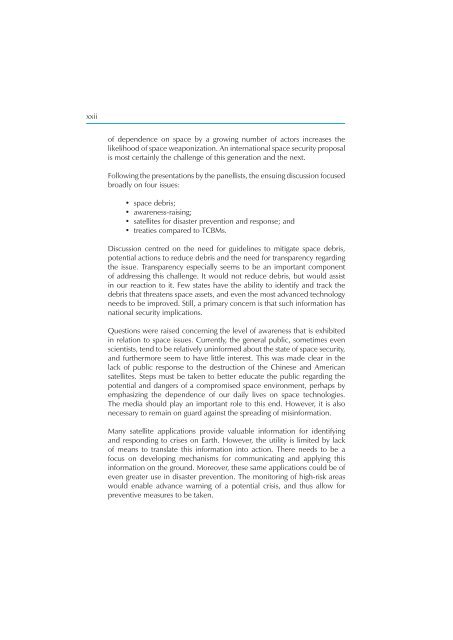Security in Space The Next Generation - UNIDIR
Security in Space The Next Generation - UNIDIR
Security in Space The Next Generation - UNIDIR
You also want an ePaper? Increase the reach of your titles
YUMPU automatically turns print PDFs into web optimized ePapers that Google loves.
xxii<br />
of dependence on space by a grow<strong>in</strong>g number of actors <strong>in</strong>creases the<br />
likelihood of space weaponization. An <strong>in</strong>ternational space security proposal<br />
is most certa<strong>in</strong>ly the challenge of this generation and the next.<br />
Follow<strong>in</strong>g the presentations by the panellists, the ensu<strong>in</strong>g discussion focused<br />
broadly on four issues:<br />
space debris;<br />
awareness-rais<strong>in</strong>g;<br />
satellites for disaster prevention and response; and<br />
treaties compared to TCBMs.<br />
Discussion centred on the need for guidel<strong>in</strong>es to mitigate space debris,<br />
potential actions to reduce debris and the need for transparency regard<strong>in</strong>g<br />
the issue. Transparency especially seems to be an important component<br />
of address<strong>in</strong>g this challenge. It would not reduce debris, but would assist<br />
<strong>in</strong> our reaction to it. Few states have the ability to identify and track the<br />
debris that threatens space assets, and even the most advanced technology<br />
needs to be improved. Still, a primary concern is that such <strong>in</strong>formation has<br />
national security implications.<br />
Questions were raised concern<strong>in</strong>g the level of awareness that is exhibited<br />
<strong>in</strong> relation to space issues. Currently, the general public, sometimes even<br />
scientists, tend to be relatively un<strong>in</strong>formed about the state of space security,<br />
and furthermore seem to have little <strong>in</strong>terest. This was made clear <strong>in</strong> the<br />
lack of public response to the destruction of the Ch<strong>in</strong>ese and American<br />
satellites. Steps must be taken to better educate the public regard<strong>in</strong>g the<br />
potential and dangers of a compromised space environment, perhaps by<br />
emphasiz<strong>in</strong>g the dependence of our daily lives on space technologies.<br />
<strong>The</strong> media should play an important role to this end. However, it is also<br />
necessary to rema<strong>in</strong> on guard aga<strong>in</strong>st the spread<strong>in</strong>g of mis<strong>in</strong>formation.<br />
Many satellite applications provide valuable <strong>in</strong>formation for identify<strong>in</strong>g<br />
and respond<strong>in</strong>g to crises on Earth. However, the utility is limited by lack<br />
of means to translate this <strong>in</strong>formation <strong>in</strong>to action. <strong>The</strong>re needs to be a<br />
focus on develop<strong>in</strong>g mechanisms for communicat<strong>in</strong>g and apply<strong>in</strong>g this<br />
<strong>in</strong>formation on the ground. Moreover, these same applications could be of<br />
even greater use <strong>in</strong> disaster prevention. <strong>The</strong> monitor<strong>in</strong>g of high-risk areas<br />
would enable advance warn<strong>in</strong>g of a potential crisis, and thus allow for<br />
preventive measures to be taken.








